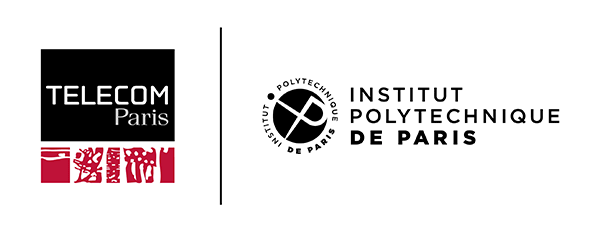
|
Telecom Paris
Dep. Informatique & Réseaux
December 2025 |


CSC_5AI25_TP: Algorithmic Information and A.I.
Lecturers: Jean-Louis Dessalles Nils Holzenberger

Objectives
Creating Artificial intelligence is one of the greatest challenges in the history of humankind. Programs are said to be "intelligent" because they solve difficult problems, such as playing the game of Go. Unfortunately, Artificial intelligence is often perceived as no more than that, just a collection of brilliant, innovative methods to solve problems. Most people don’t imagine that intelligent behaviour can be universally described in terms of algorithmic information.
There is currently a growing interest in Complexity and AIT for their role in the theoretical foundations of Artificial Intelligence. Moreover, practical approaches to complexity based on compression techniques or minimum length descriptions offer efficient techniques in machine learning. AIT plays an important role in mathematics, for instance to set limits to what a formal theory or an intelligent system can do. More recently, AIT has been shown essential to address aspects of human intelligence, such as perception, relevance, decision making and emotional intensity.
Caveat:
Content
| Chapter 1. |
Introduction to Algorithmic Information Theory (AIT) ▶ Watch the lecture |
Complexity measured by code length.
Complexity of integers. Conditional Complexity. |
| Chapter 2. |
AIT and data: Measuring Information through compression |
Compressibility.
Language recognition through compression. Huffman codes - Complexity and frequency. Zipf’s law. "Google" distance - Meaning distance. |
| Chapter 3. |
Algorithmic information applied to mathematics ▶ Watch the lecture |
Incomputability of C.
Algorithmic probability - Algorithmic Information. Randomness. Gödel’s theorem revisited. |
| Chapter 4. |
Machine Learning and Algorithmic Information
▶ Watch the lecture |
Induction - Minimum Description Length (MDL).
Analogy as complexity minimization. Machine Learning and compression. |
| Chapter 5. |
Subjective information and simplicity
▶ Watch the lecture |
| 2025 Students’ micro-studies |
| Do you have feedback or suggestions about the topics addressed in this course? |
Slides
| Chapter 4 (complexity & ML) |
Readings
À lire ➜
Validation
- Answers to questions during the lab sessions are recorded and evaluated.
- You will have to answer a short quiz on the last day.
- You will make a small original contribution (typically, as a continuation of a lab work question). The topic of the project must be related to K-complexity. You are expected to choose a topic of study, and to do something for this project (typically write a small program).
- You will write a small report (in English) to present your results. Your report should emphasize the link with Kolmogorov complexity and Algorithmic Information. All reports will be bundled up into proceedings made available to all registered students.
- You will have the opportunity to make an oral presentation of your work .
Your Project
Your project will typically build on some topic studied during the Lab Work sessions. You should pick a problem that you want to investigate further. A few suggestions are made. Initiative is welcome in any case. Note: you have to "do" something (typically write or extend a program).
- You should seek for simple and clear-cut results from which we can learn something (even if you study is inconclusive, we want to know clearly why). Initiative and logical clarity will be appreciated.
- Try to be realistic about what you can do. Your study should not be trivial, and it should lead somewhere.
- Please favour Python when writing code.
Before October 22: ➜ Please indicate here what you intend to do as a project.
. ➜ You may consult the others’ projects. Try to play a minority game in your choice!
Before November 26:
- Please upload a few slides that illustrate your work (.pdf preferred, or .ppt or .pptx; LibreOffice).
Try to be visual (please not too many bullet lists!).
DON’T SEND ANYTHING THROUGH EMAIL. Use the upload program.
Report
- Write you report ➜ Please use this template: MSWord or LibreOffice or LaTeX or Pdf
- Upload your program and any relevant material ➜ Uploading page
| Answers to the 2025 quiz |
Short bibliography
- Chaitin, G. J. (2004). On the intelligibility of the universe and the notions of simplicity, complexity and irreducibility. In W. Hogrebe & J. Bromand (Eds.), Grenzen und Grenzüberschreitungen, XIX, 517-534. Berlin: Akademie Verlag.Devine, S. D. (2014). Algorithmic information theory: Review for physicists and natural scientists. .
- Chaitin, G. J. (2005). Meta Math! The quest for Omega. Vintage Books, ed. 2006.
- Chater, N. (1999). The search for simplicity: A fundamental cognitive principle?. The Quarterly Journal of Experimental Psychology, 52 (A), 273-302.
- Downey, R. G. & Hirschfeldt, D. R. (2010). Algorithmic randomness and complexity. New York: Springer.
- Grünwald, P. D. (2007). The minimum description length principle. MIT press.
- Hutter, M. (2005). Universal artificial intelligence: Sequential decisions based on algorithmic probability. Berlin: Springer.Li, M. & Vitányi, P. (1993). An introduction to Kolmogorov complexity and its applications (3rd ed.). New York: Springer Verlag, ed. 1997.
- Li, M. & Vitányi, P. (1993). An introduction to Kolmogorov complexity and its applications (3rd ed.). New York: Springer Verlag, ed. 1997.
- Solomonoff, R. J. (1997). The discovery of algorithmic probability. Journal of Computer and System Sciences, 55 (1), 73-88.
- Solomonoff, R. J. (1978). Complexity-based induction systems: Comparisons and convergence theorems. IEEE transactions on Information Theory, 24 (4), 422-432.
- Vitányi, P. & Li, M. (2001). Simplicity, information, Kolmogorov complexity and prediction. In A. Zellner, H. A. Keuzenkampf & M. McAleer (Eds.), Simplicity, inference and modelling: Keeping it sophisticatedly simple, 135-155. Cambridge, UK: Cambridge University Press.
- Zenil, H. (2013). A computable universe: understanding and exploring nature as computation. World Scientific.
- Delahaye, J.-P. (1994). Information, complexité et hasard. Paris: Hermès, ed. 1999.
- Delahaye, J-P. (2013). Définir et mesurer la complexité : La théorie algorithmique de l’information. 1024 - Bulletin de la Société Informatique de France, 1, 35-53.
- Dessalles, J.-L. (2008). La pertinence et ses origines cognitives - Nouvelles théories. Paris: Hermes Science.

